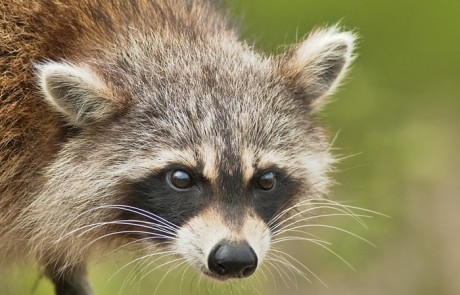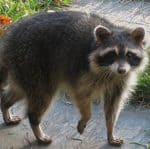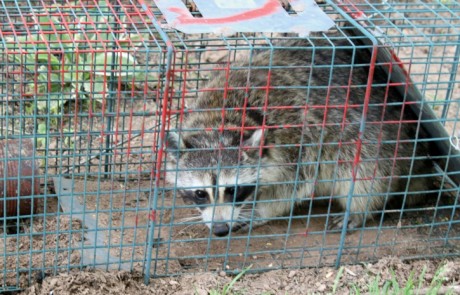Votre panier est actuellement vide !

The raccoon
It is easy to distinguish the Raccoon from other animals by its white and black ringed tail, as well as by its very characteristic black mask.The Raccoon is a robust animal of medium size.Measures between 65 and 96 centimeters in total lengthWeighs between 6.5 and 16 kg.
Latin Name: Procyon lotor
Description:The Raccoon is easily distinguished from other animals by its white and black ringed tail, as well as its distinctive black mask.The Raccoon is a robust animal of medium size.Measures between 65 and 96 centimeters in total lengthWeighs between 6.5 and 16 kilograms.However, adults weighing up to 28 kilograms have been observed in the autumn.The male is usually larger than the female. His small, delicate hands are extremely sensitive and very adept at handling small objects.He has short legs whose narrow feet equipped with claws help him climb trees well.In addition to being very comfortable in trees, the Raccoon is a good swimmer.On land, however, it is quite vulnerable because it is rather slow.The annual molt (change of coat) begins in the spring and lasts for about three months.
Reproduction:Mating occurs mostly in March. The young are most often born in May.Polygamous, the male will impregnate several females successively.The female, on the other hand, is monogamous and, after mating with one male, she will repel all the others.Often, the young females mate during the first year. Litter sizes tend to be larger in northern areas, with three to seven young often being born, while in the south they are usually two to three. Gestation (the period during which the mother carries her young) lasts an average of 63 days.at birth, the young have no teeth, their eyes are closed and they weigh about 75 g.Teeth will break through 19 days later while the eyes will open at the age of two and a half weeks.about ten days after birth, the young already display the mask and the coat characteristic of the species. The cubs stay in the mother’s den for about eight weeks and then accompany their mother in her search for food, although they are not fully weaned until they are two months old.The male does not participate in their rearing.The family unit consists of the mother and her cubs. The family unit consists of the mother and her cubs and they are quite social, foraging together at night and sharing the same den during the day.During the first summer, the mother teaches her young how to climb, hunt and swim. The family usually does not disband until the next litter arrives, normally the following spring.Young males often leave the mothers’ territory while young females may stick around.Longevity of the species is said to vary between three and five years in the wild; the majority of the population is completely replaced within seven years
Habits:The raccoon can live in a range of habitats. It appears to need only a source of water, food, and shelter. Hollow trees, stumps, logs, caves, unoccupied groundhog or fox dens, and barns or other such buildings are among the raccoon’s favorite shelters. In urban areas, raccoons may choose a chimney, sewer, garage, attic, tree, or culvert.Raccoon movements and territory vary greatly depending on habitat, population density, and food sources. The territory is the area where the animal finds food, water and shelter during its daily movements. In the agricultural areas of eastern North America, raccoon territory ranges from 1 to 4 km2, while in the prairies it can be as large as 50 km2. In contrast, less than 0.1 km2 has been found in urban areas. Population densities also vary greatly with habitat type. Population density also varies greatly depending on the type of habitat. For example, it is estimated that agricultural areas often support five to ten raccoons per square kilometer, while an exceptional density of 100 individuals per square kilometer has been noted in urban areas.Raccoons are omnivorous and will eat just about anything, including both plant and animal foods. It prefers corn, crayfish, fruits and nuts, but its diet varies with the seasons. In the spring, animals, invertebrates (small animals without a backbone) and insects make up most of their diet. Crayfish are the most popular, but muskrats, squirrels, rabbits, waterfowl eggs and freshwater clams are also eaten. In summer, they are more attracted to plants including fruits and nuts. They enjoy wild cherries, currants, elderberries, wild grapes, strawberries, potatoes and sweet corn. They also eat frogs, small fish, turtles, chafer larvae, grasshoppers, earthworms, crickets and snails during the summer months. In most areas where corn is grown, it is the mainstay of the fall diet, but acorns, beechnuts, hazelnuts and grapes are also popular. The animal does not hesitate to plunder insect nests, such as hornets, bumblebees, termites and ants to eat the larvae (first stage of development). The fall diet is extremely important for the northern raccoon as it needs to build up sufficient fat reserves for the winter. The entire body, including the tail bone, is covered with a layer of fat that can be up to 2.5 cm thick on the back. In fact, it can make up more than half the animal’s total weight by late fall. In northern regions, raccoons live off their adipose (fat) reserves during the winter, while in the south, where nuts and corn are plentiful, they continue to forage year-round. On the outskirts of cities, they are often seen scavenging in garbage cans or patrolling lawns for earthworms, beetles and grubs. It can also be a nuisance to farmers as it sometimes preys on poultry and takes eggs.During the winter numbness, the body temperature does not drop and the ambient temperature seems to govern the animal’s activity. Adult males are often alone in their den, but it is not uncommon to see a family spending their first winter together.Community burrows of up to 23 individuals have been observed, but they are most often four or five. Although they use only one den during the winter, raccoons have several shelters for the other seasons.
Prevention:As raccoons do not have many predators, it is difficult to prevent them from coming around our homes if they find shelter and food there. In urban areas, it is accused of ravaging garages, vegetable gardens, lawns and roofs of homes. To get rid of a pest, the only solution is often to trap it and release it elsewhere. We recommend that you have the work done by a specialist because these animals, which look very calm and peaceful, are often aggressive when captured.

